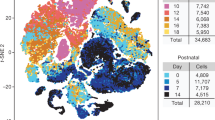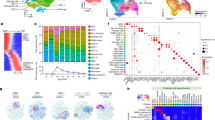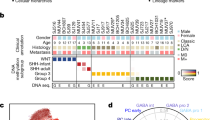Abstract
Cells with stem cell properties have been isolated from various areas of the postnatal mammalian brain, most recently from the postnatal mouse cerebellum. We show here that inactivation of the tumor suppressor genes Rb and p53 in these endogenous neural stem cells induced deregulated proliferation and resistance to apoptosis in vitro. Moreover, injection of these cells into mice formed medulloblastomas. Medulloblastomas are the most common malignant brain tumors of childhood, and despite recent advances in treatment they are associated with high morbidity and mortality. They are highly heterogeneous tumors characterized by a diverse genetic make-up and expression profile as well as variable prognosis. Here, we describe a novel ontogenetic pathway of medulloblastoma that significantly contributes to understanding their heterogeneity. Experimental medulloblastomas originating from neural stem cells preferentially expressed stem cell markers Nestin, Sox2 and Sox9, which were not expressed in medulloblastomas originating from granule-cell-restricted progenitors. Furthermore, the expression of these markers identified a subset of human medulloblastomas associated with a poorer clinical outcome.
This is a preview of subscription content, access via your institution
Access options
Subscribe to this journal
Receive 50 print issues and online access
$259.00 per year
only $5.18 per issue
Buy this article
- Purchase on Springer Link
- Instant access to full article PDF
Prices may be subject to local taxes which are calculated during checkout





Similar content being viewed by others
References
Akagi K, Sandig V, Vooijs M, Van der Valk M, Giovannini M, Strauss M et al. (1997). Cre-mediated somatic site-specific recombination in mice. Nucleic Acids Res 25: 1766–1773.
Alcantara Llaguno S, Chen J, Kwon CH, Jackson EL, Li Y, Burns DK et al. (2009). Malignant astrocytomas originate from neural stem/progenitor cells in a somatic tumor suppressor mouse model. Cancer Cell 15: 45–56.
Bar EE, Chaudhry A, Lin A, Fan X, Schreck K, Matsui W et al. (2007). Cyclopamine-mediated hedgehog pathway inhibition depletes stem-like cancer cells in glioblastoma. Stem Cells 25: 2524–2533.
Behesti H, Marino S . (2009). Cerebellar granule cells: insights into proliferation, differentiation, and role in medulloblastoma pathogenesis. Int J Biochem Cell Biol 41: 435–445.
Bigelow RL, Chari NS, Unden AB, Spurgers KB, Lee S, Roop DR et al. (2004). Transcriptional regulation of bcl-2 mediated by the sonic hedgehog signaling pathway through gli-1. J Biol Chem 279: 1197–1205.
Cheung M, Briscoe J . (2003). Neural crest development is regulated by the transcription factor Sox9. Development 130: 5681–5693.
Corti S, Nizzardo M, Nardini M, Donadoni C, Locatelli F, Papadimitriou D et al. (2007). Isolation and characterization of murine neural stem/progenitor cells based on Prominin-1 expression. Exp Neurol 205: 547–562.
Crawford JR, MacDonald TJ, Packer RJ . (2007). Medulloblastoma in childhood: new biological advances. Lancet Neurol 6: 1073–1085.
de Bont JM, Kros JM, Passier MM, Reddingius RE, Sillevis Smitt PA, Luider TM et al. (2008). Differential expression and prognostic significance of SOX genes in pediatric medulloblastoma and ependymoma identified by microarray analysis. Neuro Oncol 10: 648–660.
Drescher DG, Green GE, Khan KM, Hajela K, Beisel KW, Morley BJ et al. (1993). Analysis of gamma-aminobutyric acidA receptor subunits in the mouse cochlea by means of the polymerase chain reaction. J Neurochem 61: 1167–1170.
Eberhart CG . (2003). Medulloblastoma in mice lacking p53 and PARP: all roads lead to Gli. Am J Pathol 162: 7–10.
Ellis P, Fagan BM, Magness ST, Hutton S, Taranova O, Hayashi S et al. (2004). SOX2, a persistent marker for multipotential neural stem cells derived from embryonic stem cells, the embryo or the adult. Dev Neurosci 26: 148–165.
Ellison DW, Onilude OE, Lindsey JC, Lusher ME, Weston CL, Taylor RE et al. (2005). Beta-Catenin status predicts a favorable outcome in childhood medulloblastoma: the United Kingdom Children's Cancer Study Group Brain Tumour Committee. J Clin Oncol 23: 7951–7957.
Ferri AL, Cavallaro M, Braida D, Di Cristofano A, Canta A, Vezzani A et al. (2004). ox2 deficiency causes neurodegeneration and impaired neurogenesis in the adult mouse brain. Development 131: 3805–3819.
Foroni C, Galli R, Cipelletti B, Caumo A, Alberti S, Fiocco R et al. (2007). Resilience to transformation and inherent genetic and functional stability of adult neural stem cells ex vivo. Cancer Res 67: 3725–3733.
Galli R, Gritti A, Vescovi AL . (2008). Adult neural stem cells. Methods Mol Biol 438: 67–84.
Gilbertson RJ, Ellison DW . (2008). The origins of medulloblastoma subtypes. Annu Rev Pathol 3: 341–365.
Goodrich LV, Milenkovic L, Higgins KM, Scott MP . (1997). Altered neural cell fates and medulloblastoma in mouse patched mutants. Science 277: 1109–1113.
Hahn H, Wicking C, Zaphiropoulous PG, Gailani MR, Shanley S, Chidambaram A et al. (1996). Mutations of the human homolog of Drosophila patched in the nevoid basal cell carcinoma syndrome. Cell 85: 841–851.
Huang H, Mahler-Araujo BM, Sankila A, Chimelli L, Yonekawa Y, Kleihues P et al. (2000). APC mutations in sporadic medulloblastomas. Am J Pathol 156: 433–437.
Jackson EL, Garcia-Verdugo JM, Gil-Perotin S, Roy M, Quinones-Hinojosa A, VandenBerg S et al. (2006). PDGFR alpha-positive B cells are neural stem cells in the adult SVZ that form glioma-like growths in response to increased PDGF signaling. Neuron 51: 187–199.
Johnson RL, Rothman AL, Xie J, Goodrich LV, Bare JW, Bonifas JM et al. (1996). Human homolog of patched, a candidate gene for the basal cell nevus syndrome. Science 272: 1668–1671.
Kimura H, Stephen D, Joyner A, Curran T . (2005). Gli1 is important for medulloblastoma formation in Ptc1+/− mice. Oncogene 24: 4026–4036.
Lee A, Kessler JD, Read TA, Kaiser C, Corbeil D, Huttner WB et al. (2005). Isolation of neural stem cells from the postnatal cerebellum. Nat Neurosci 8: 723–729.
Lee J, Platt KA, Censullo P, Ruiz i Altaba A . (1997). Gli1 is a target of Sonic hedgehog that induces ventral neural tube development. Development 124: 2537–2552.
Lee Y, Miller HL, Jensen P, Hernan R, Connelly M, Wetmore C et al. (2003). A molecular fingerprint for medulloblastoma. Cancer Res 63: 5428–5437.
Lumpkin EA, Collisson T, Parab P, Omer-Abdalla A, Haeberle H, Chen P et al. (2003). Math1-driven GFP expression in the developing nervous system of transgenic mice. Gene Expr Patterns 3: 389–395.
Marino S, Vooijs M, van Der Gulden H, Jonkers J, Berns A . (2000). Induction of medulloblastomas in p53-null mutant mice by somatic inactivation of Rb in the external granular layer cells of the cerebellum. Genes Dev 14: 994–1004.
Meuwissen R, Linn SC, Linnoila RI, Zevenhoven J, Mooi WJ, Berns A . (2003). Induction of small cell lung cancer by somatic inactivation of both Trp53 and Rb1 in a conditional mouse model. Cancer Cell 4: 181–189.
Palma V, Lim DA, Dahmane N, Sanchez P, Brionne TC, Herzberg CD et al. (2005). Sonic hedgehog controls stem cell behavior in the postnatal and adult brain. Development 132: 335–344.
Palma V, Ruiz i Altaba A . (2004). Hedgehog-GLI signaling regulates the behavior of cells with stem cell properties in the developing neocortex. Development 131: 337–345.
Pfenninger CV, Roschupkina T, Hertwig F, Kottwitz D, Englund E, Bengzon J et al. (2007). CD133 is not present on neurogenic astrocytes in the adult subventricular zone, but on embryonic neural stem cells, ependymal cells, and glioblastoma cells. Cancer Res 67: 5727–5736.
Phi JH, Park SH, Kim SK, Paek SH, Kim JH, Lee YJ et al. (2008). Sox2 expression in brain tumors: a reflection of the neuroglial differentiation pathway. Am J Surg Pathol 32: 103–112.
Pomeroy SL, Tamayo P, Gaasenbeek M, Sturla LM, Angelo M, McLaughlin ME et al. (2002). Prediction of central nervous system embryonal tumour outcome based on gene expression. Nature 415: 436–442.
Rajewsky K, Gu H, Kuhn R, Betz UA, Muller W, Roes J et al. (1996). Conditional gene targeting. J Clin Invest 98: 600–603.
Romer JT, Kimura H, Magdaleno S, Sasai K, Fuller C, Baines H et al. (2004). Suppression of the Shh pathway using a small molecule inhibitor eliminates medulloblastoma in Ptc1(+/−)p53(−/−) mice. Cancer Cell 6: 229–240.
Schuller U, Heine VM, Mao J, Kho AT, Dillon AK, Han YG et al. (2008). Acquisition of granule neuron precursor identity is a critical determinant of progenitor cell competence to form Shh-induced medulloblastoma. Cancer Cell 14: 123–134.
Shakhova O, Leung C, van Montfort E, Berns A, Marino S . (2006). Lack of Rb and p53 delays cerebellar development and predisposes to large cell anaplastic medulloblastoma through amplification of N-Myc and Ptch2. Cancer Res 66: 5190–5200.
Shu Q, Wong KK, Su JM, Adesina AM, Yu LT, Tsang YT et al. (2008). Direct orthotopic transplantation of fresh surgical specimen preserves CD133+ tumor cells in clinically relevant mouse models of medulloblastoma and glioma. Stem Cells 26: 1414–1424.
Soriano P . (1999). Generalized lacZ expression with the ROSA26 Cre reporter strain. Nat Genet 21: 70–71.
Sottile V, Li M, Scotting PJ . (2006). Stem cell marker expression in the Bergmann glia population of the adult mouse brain. Brain Res 1099: 8–17.
Suh H, Consiglio A, Ray J, Sawai T, D'Amour KA, Gage FH . (2007). in vivo fate analysis reveals the multipotent and self-renewal capacities of Sox2+ neural stem cells in the adult hippocampus. Cell Stem Cell 1: 515–528.
Taylor MD, Liu L, Raffel C, Hui CC, Mainprize TG, Zhang X et al. (2002). Mutations in SUFU predispose to medulloblastoma. Nat Genet 31: 306–310.
Tong WM, Ohgaki H, Huang H, Granier C, Kleihues P, Wang ZQ . (2003). Null mutation of DNA strand break-binding molecule poly(ADP-ribose) polymerase causes medulloblastomas in p53(−/−) mice. Am J Pathol 162: 343–352.
Weiss WA, Israel M, Cobbs C, Holland E, James CD, Louis DN et al. (2002). Neuropathology of genetically engineered mice: consensus report and recommendations from an international forum. Oncogene 21: 7453–7463.
Yang ZJ, Ellis T, Markant SL, Read TA, Kessler JD, Bourboulas M et al. (2008). Medulloblastoma can be initiated by deletion of Patched in lineage-restricted progenitors or stem cells. Cancer Cell 14: 135–145.
Zhao H, Ayrault O, Zindy F, Kim JH, Roussel MF . (2008). Post-transcriptional down-regulation of Atoh1/Math1 by bone morphogenic proteins suppresses medulloblastoma development. Genes Dev 22: 722–727.
Zheng H, Ying H, Yan H, Kimmelman AC, Hiller DJ, Chen AJ et al. (2008). p53 and Pten control neural and glioma stem/progenitor cell renewal and differentiation. Nature 455: 1129–1133.
Zurawel RH, Allen C, Chiappa S, Cato W, Biegel J, Cogen P et al. (2000). Analysis of PTCH/SMO/SHH pathway genes in medulloblastoma. Genes Chromosomes Cancer 27: 44–51.
Acknowledgements
We thank Rob Wechsler-Reya and James Briscoe for the gift of ptc+/− medulloblastoma pellets and Sox9 antibody respectively. We thank Gary Warnes for expert assistance with the flow cytometry analysis. This work was supported by grants of St Bartholomew's Charitable Foundation, Cancer Research UK, Ali's Dream and Charlie's Challenge Charities to SM and by personal fellowships of Janggen-Pöhn Foundation and Swiss National Science Foundation to RS.
Author information
Authors and Affiliations
Corresponding author
Additional information
Supplementary Information accompanies the paper on the Oncogene website (http://www.nature.com/onc)
Rights and permissions
About this article
Cite this article
Sutter, R., Shakhova, O., Bhagat, H. et al. Cerebellar stem cells act as medulloblastoma-initiating cells in a mouse model and a neural stem cell signature characterizes a subset of human medulloblastomas. Oncogene 29, 1845–1856 (2010). https://doi.org/10.1038/onc.2009.472
Received:
Revised:
Accepted:
Published:
Issue Date:
DOI: https://doi.org/10.1038/onc.2009.472
Keywords
This article is cited by
-
Innovative mouse models for the tumor suppressor activity of Protocadherin-10 isoforms
BMC Cancer (2022)
-
The AHR pathway represses TGFβ-SMAD3 signalling and has a potent tumour suppressive role in SHH medulloblastoma
Scientific Reports (2020)
-
Medulloblastoma: experimental models and reality
Acta Neuropathologica (2017)
-
Consensus Paper: Cerebellar Development
The Cerebellum (2016)
-
SOX9 Overexpression Promotes Glioma Metastasis via Wnt/β-Catenin Signaling
Cell Biochemistry and Biophysics (2015)



